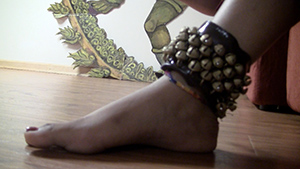Found: Classical Indian Dance
By Melanie Lustig
In the curve of a hand or the step of a foot, there is meaning. This is an integral part of Indian cultural dance, according to Sudha Raj, a Bharatanatyam dance instructor in Syracuse.
Formed in 1982 by Raj and two of her friends, this South Indian Classical Dance troupe was created as a way to keep their Indian culture alive in the United States. These ladies brought three different styles of dance to the experience.
“We were young and we wanted to dance,” Raj said. “We were all from different parts of India, and dance was the common thread that bound us together.”
Indian dance consists of three elements according to Raj: Nritta, “pure abstract movement” where the hands, feet, neck and eyes create geometric patterns with no real meaning; Nritya, or hand gestures, that have meaning and are a form of “speaking” through movement, and Abhinaya, facial expressions that accompany the movements and are “pure, uninhibited emotion.”
Raj teaches South Indian Classical Dance once a week at Rockefeller United Methodist Church on Nottingham Road. Her group has performed at local schools and events, as well as in the Syracuse Opera’s “The Pearl Fishers” in 2011. Although Raj no longer does much dancing herself, her daughter Mina Raj continues the tradition as both a dancer and a choreographer.


